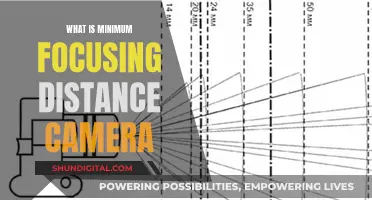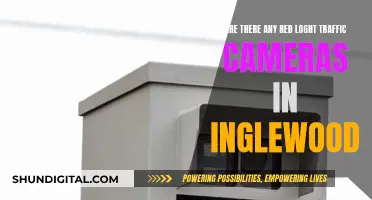
Focus stacking is a technique used by photographers to create images with a sharp subject from front to back, while still maintaining a soft, defocused background. This is achieved by capturing a sequence of photos, each with a slightly different focal point, and then merging the in-focus areas into a single image. While this process can be done manually, some cameras now offer built-in focus stacking capabilities, which automate the shooting process.
Some of the camera models that offer focus stacking include the Panasonic G90/G95, Panasonic GX9, Panasonic GH5, Panasonic GX800/GX850, Fujifilm X-Pro3, Olympus OM-D E-M1, and the Canon EOS R7 and EOS R10. Additionally, certain Nikon, Sony, and Fujifilm models also offer focus bracketing, which is a similar process that can be used to achieve focus stacking.
| Characteristics | Values |
|---|---|
| Camera models with built-in focus stacking | Panasonic Lumix G90/G95/G91, Panasonic GX9, Panasonic GH5/GH5S, Panasonic GX800/GX850, Panasonic G80/G85, Panasonic G7, Olympus OM-D E-M1, Olympus OM-D E-M5 Mark III, Olympus OM-D E-M5 Mark II, Fujifilm X-Pro3 |
| Camera models with focus bracketing | Canon R6, Canon R7, Sony Alpha 1, Canon 6D, Canon M6M2, Fujifilm GFX 100s, Nikon D780, Olympus OM-D E-M10 IV, Olympus OM-D E-M10 Mark III |
What You'll Learn

Cameras with focus stacking capabilities
Focus stacking is a technique used by photographers, especially those interested in macro and landscape photography, to achieve maximum depth of field in their images. It involves capturing a sequence of images at slightly different focal positions and then merging the areas in focus into a single image. While this used to be done manually, several camera manufacturers have introduced built-in focus stacking capabilities in recent years, simplifying the process of creating sharp macro photos.
Panasonic
Panasonic was one of the first manufacturers to introduce a built-in focus stacking mode in its cameras. Its focus stacking feature works by shooting a brief 4K video of the scene, during which the camera shifts the focal position from the closest object to the one furthest away. The camera then merges the sharp areas from the frames in this video to create a final image with a wide depth of field. The Panasonic G90 (known as the Panasonic Lumix G95 and G91 in some territories), the Panasonic GX9, the Panasonic GH5, the Panasonic GX800/GX850, the Panasonic G80/G85, and the Panasonic G7 are some of the Panasonic cameras that offer this feature.
Olympus
Olympus was another early adopter of built-in focus stacking capabilities, introducing the feature to the OM-D E-M1 via a firmware update. This feature has since been added to many subsequent Olympus cameras, including the OM-D E-M1 Mark II, the OM-D E-M5 Mark III, the OM-D E-M5 Mark II, the OM-D E-M1X, the OM-D E-M10 IV, and the OM-D E-M10 Mark III. It is important to note that not every lens is compatible with the focus bracketing/stacking feature, and some Olympus lenses only allow for bracketing without the built-in focus stacking.
Fujifilm
Fujifilm has also introduced focus stacking capabilities in some of its cameras, such as the Fujifilm X-Pro3. This feature automates the first step in the focus stacking process by capturing a series of images with different focus points. The camera calculates the shift in focus required and the number of images needed based on the lens focal length, selected aperture, and requested sharpness range. While Fujifilm does not supply image-merging software, the stacked images can be combined using software like Adobe Photoshop.
Canon
Canon has also incorporated focus stacking capabilities in some of its cameras, including the Canon EOS R3, the Canon EOS R5, the Canon EOS R6 Mark II, the Canon EOS R6, the Canon EOS RP, the Canon EOS R7, the Canon EOS R10, the Canon EOS 90D, the Canon EOS M6 Mark II, and the Canon PowerShot G5 X Mark II.
Other Brands
In addition to the brands mentioned above, Nikon and Sony also offer cameras with focus stacking capabilities. The Nikon D780 and the Sony A7RV are two examples of cameras from these brands that support this feature.
The Evolution of Photography: First Camera Invention
You may want to see also

Focus stacking vs. high-resolution modes
Focus stacking is a technique in photography that helps achieve an astounding depth of field and breathtaking clarity in images. It involves taking multiple shots at various focus points and blending them into a single image. This technique is especially useful in macro and landscape photography, enhancing depth of field without losing clarity.
High-resolution modes, on the other hand, are used to create super high-resolution images by merging several images of the same scene. For example, Olympus cameras have a Pixel Shift mode that creates 48-megapixel images by merging multiple shots.
Cameras with built-in focus stacking, like those from Panasonic and Olympus, simplify the traditional focus stacking process by automatically merging images with different focus points. This results in a final image with a wider depth of field. It is important to note that focus stacking does not increase the resolution of the images but instead focuses on harvesting the zones of focus.
When deciding between focus stacking and high-resolution modes, it is essential to consider the specific requirements of the shot. If the goal is to capture fine details and enhance the depth of field, focus stacking is the way to go. On the other hand, if the priority is to create a single image with an extremely high resolution, high-resolution modes would be more suitable.
Additionally, it is worth mentioning that focus stacking is particularly useful when working with very deep landscape scenes, ultra-close macro subjects, or deep building interiors. In these situations, a single shot might not provide sufficient depth of field, and focus stacking becomes a valuable tool.
In conclusion, both focus stacking and high-resolution modes have their unique purposes. Focus stacking excels at enhancing depth of field and capturing fine details, while high-resolution modes are designed to create extremely high-resolution images by merging multiple shots. The choice between the two depends on the specific needs of the photographer and the desired outcome of the image.
Mastering Autofocus: The Cinema Camera Advantage
You may want to see also

Focus bracketing vs. focus stacking
Focus bracketing and focus stacking are two photography techniques used to create images with a larger depth of field than what can be captured in a single frame. This is achieved by taking multiple photographs while progressively shifting the focus point across the depth of the subject.
Focus bracketing is the process of capturing multiple images of the same subject, each with a different area in focus. This technique is often used to ensure different parts of the subject are in focus, allowing for the desired frame selection or to be used for focus stacking.
Focus stacking is the process of combining the images taken during focus bracketing into a single image with an extended depth of field. This technique is used to create images that are sharp from front to back. Focus stacking is particularly useful when the subject being photographed is not moving and is a common technique used in landscape, macro, and product photography.
While focus bracketing and focus stacking are technically different techniques, they are often used together and the terms are sometimes used interchangeably.
To create a focus-stacked image without built-in camera functionality, photographers can use third-party software such as Adobe Photoshop, Lightroom, or Helicon Focus.
Some cameras with built-in focus bracketing and focus stacking functionality include:
- Olympus OM-D E-M1, E-M1 Mark II, E-M1 Mark III, E-M5 Mark III, and E-M5 Mark II
- Panasonic GX800/GX850, G9, G80/G85, G7, and GX9
- Fujifilm X-Pro3
- Sony ILCE-6700, ILCE-7RM5, and ILCE-9M3
- Canon EOS R3, EOS R5, EOS R6 Mark II, EOS R6, EOS RP, EOS R7, EOS R10, EOS 90D, EOS M6 Mark II, PowerShot G5 X Mark II, and PowerShot G7 X Mark III
Finding the Mode Button on the Hero 5 Camera
You may want to see also

Cameras with focus bracketing
Focus bracketing is a feature that allows you to capture a sequence of images at different focus distances, which can then be combined into a single image with a greater depth of field. This technique is particularly useful for macro and landscape photography, where achieving a large depth of field can be challenging.
Canon
The Canon EOS R7 and EOS R10 are notable for introducing in-camera stacking and cropping of depth-composite images during focus bracketing. Other Canon cameras with focus bracketing include the EOS R3, EOS R5, EOS R6 Mark II, EOS R6, EOS RP, EOS 90D, EOS M6 Mark II, and PowerShot G5 X Mark II.
Fujifilm
Fujifilm offers in-camera focus bracketing with models such as the X-Pro3, GFX 100s, and GFX 100. Their focus bracketing feature allows you to set the number of frames, the interval between shots, and the focus differential.
Olympus
Olympus has incorporated focus bracketing in several of their OM-D cameras, including the E-M10 IV, E-M10 Mark III, E-M1, E-M5 Mark III, and E-M1 Mark II. Their focus bracketing feature allows you to adjust the number of shots and the focus differential. Additionally, Olympus offers the Tough series (TG-5+) and some PEN series cameras with focus bracketing capabilities.
Panasonic
Panasonic was one of the first manufacturers to introduce a built-in focus stacking mode, which is an extension of its 4K Photo and Post Focus modes. The Panasonic G90/G95, GX9, GH5/GH5S, GX800/GX850, G80/G85, and G7 are some models that offer focus bracketing.
Nikon
The Nikon D780 offers focus bracketing with a cap of 300 images and includes features like time between shots, step width, and focus peeking.
Sony
The Sony Alpha 1 is mentioned as a camera with fast performance but lacking internal focus bracketing.
Unlocking Camera's Potential: Expert Mode Explained
You may want to see also

Tips for focus stacking composition
Focus stacking is a powerful technique that can take your photography to the next level, allowing you to achieve an incredible depth of field and breathtaking clarity in your shots. Here are some tips to help you master the art of focus stacking composition:
Understand When to Use Focus Stacking
Know when focus stacking is necessary. It is ideal when you want multiple elements at varying distances to be completely in focus. This is often the case when shooting landscapes, products, or macro photography. In these scenarios, a single image with everything in sharp focus may be impossible to capture without focus stacking.
Choose the Right Equipment
While focus stacking can be done with just a standard camera or even a smartphone, investing in the right equipment can greatly improve your results. Consider using a tripod to keep your camera steady and ensure consistent composition across multiple shots. Use a camera with manual mode capabilities and manual focusing options for precise control over the point of focus. Additionally, consider focus-stacking software or photo editing software with layer masking options for post-processing.
Plan Your Composition
Carefully compose your shot and be sure about your composition before starting the focus stacking process. Focus stacking involves merging multiple images, so any changes in composition between shots will require starting the process over. Shoot slightly wider than normal to allow for slight cropping that may be needed during the merging process.
Maintain Consistency in Exposure
Consistency in exposure across all the images is crucial for successful focus stacking. Shoot in manual mode to have full control over the exposure settings. Keep the ISO low to avoid image noise, and use a faster shutter speed to ensure sharp images. Remember that each stacked image should have the same exposure settings.
Focus on Different Sections of the Image
Start by focusing on the area of the photo that is closest to the lens and take the first shot. Then, change the focal point to the next section of the image, taking a photo at each step. Slowly move the focal point backward until you've captured sharp images of every section.
Handle Moving Subjects Carefully
Focus stacking works best with stationary subjects. If there is movement in your scene, such as a tree blowing in the wind, it will be challenging to blend the images effectively. Try to minimise movement, or consider using manual masking techniques to overlay the moving subject with sufficient depth of field in a single image.
Try Handheld Focus Stacking
While using a tripod is recommended, it's not always practical. Handheld focus stacking can produce impressive results, but it requires you to keep your framing consistent across all the images. Stabilise yourself by leaning against an object or finding a comfortable position. The key is to minimise camera movement between shots.
Combine Focus Stacking with HDR for Dynamic Scenes
If you're shooting a scene with a high dynamic range, you can combine focus stacking with HDR techniques. Capture multiple images for each focus point, exposing separately for different tones in the image. First, merge each set of bracketed images to create an HDR version, and then continue with the standard focus stacking process.
Use a Focusing Rail for Macro Stacking
When working with macro photography, a focusing rail can be extremely helpful. It attaches to your tripod and allows for precise, incremental adjustments in the focus position, making it easier to capture a series of images for stacking.
Practice and Experiment
Focus stacking is a technique that requires some practice to master. Experiment with different subjects, compositions, and lighting conditions to refine your skills. With time, you'll develop a better understanding of when and how to use focus stacking to create stunningly sharp photographs.
Dodge Charger GT: Reverse Camera Availability
You may want to see also







